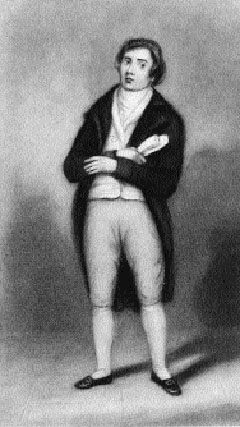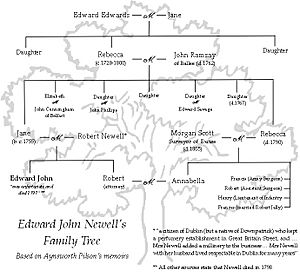Edward John Newell facts for kids
Quick facts for kids
Edward John Newell
|
|
|---|---|
| Born | 1771 |
| Died | 1798 (aged 26–27) |
| Nationality | Irish |
Edward John Newell (1771–1798) was an Irish sailor, artist, and painter. He became well-known for secretly working for the government during a time of political trouble in the 1790s. After joining a group called the Society of United Irishmen in 1796, he offered to help the British government. In 1798, he published a book about his life. Soon after, he disappeared, and people thought he might have been killed.
Contents
Edward John Newell's Early Life
Newell was born in Downpatrick on June 29, 1771. His parents were Robert and Jane Newell. His family had Scottish roots. As a child, Edward sometimes got into trouble. He often pretended to be someone he wasn't when he was with his friends.
Aynsworth Pilson, who wrote about his own life, said that Newell's parents lived in Dublin before moving back to Downpatrick. Robert Newell ran a perfume shop in Dublin. Jane Newell had a business that made hats.
When Newell was seventeen, his father was badly hurt in a horse accident. His mother left Edward in charge of their home to care for Robert. Edward then left his younger brother and the house. He went to visit his sick father at his uncle's home. His mother, who wasn't very warm towards Edward, was not happy to see him.
Newell's Jobs and Travels
After a disagreement with his mother, Edward looked for work. He met Captain Johnson, who hired him as a sailor. Newell soon sailed to Cadiz, Spain. He spent about a year at sea. He later described how hard it was, including a "dreadful storm." He also mentioned living for six weeks on "raw meat" and always working the ship's pumps.
After returning home to Dublin, he told his father about his trip. His father asked Newell to settle down. He found him a job in a painting and glass business. Newell wrote that he didn't really want to do this job. He worked there for about a year until his "usual bad habits" caused a problem with his boss.
Newell then became a glass-stainer for two years. After that, he had another falling out with his boss and his father.
He tried to move to America but failed. Then he moved to Limerick and Dublin. He tried to find jobs but never kept one for long. He became very poor. When he asked his parents for help, they refused. They didn't help him because he strongly supported the United Irishmen.
In 1796, Newell moved to Belfast. There, he started his own business painting portraits and miniatures. Newell had never tried miniature painting before. He had not received any training for it.
Two of Newell's known paintings are a self-portrait. He included this in his later book about his life. The other is a portrait of Betsy Gray. She was a woman who fought and died at the Battle of Ballynahinch.
Newell: A Spy Among the United Irishmen
Newell officially joined the Society of United Irishmen in 1796. This group wanted Ireland to be independent.
Newell became so excited about the United Irishmen that he didn't pay attention to his business. This quickly made the group's leaders suspicious of him. His younger brother, Robert, who was not part of the United Irishmen, said that Newell would go through Belfast. He would dress up like a soldier, blacken his face, and be with real soldiers. He would point out people who were then arrested and put in prison.
Through his painting business, Newell met George Murdoch. Newell painted the inside and outside of Murdoch's house. Murdoch and Newell had very different political views. Their friendship made the United Irishmen trust Newell even less. Newell even hired guards to protect Murdoch's house because they were friends. Newell later wrote that Murdoch told him he knew Newell was a rebel. However, Madden, who wrote about Newell in 1843, said that Newell "betrayed the secrets of the United Irish Society" to stop an exciseman named Murdock from being killed.
Edward Cooke, a government official, brought Newell to Dublin Castle for questioning. Newell wrote that he was treated well and even offered wine. Newell asked to be forgiven for his actions in exchange for what he knew. The Lord Lieutenant (a high-ranking government official) agreed to this in writing. Cooke first questioned Newell for nine hours.
Newell was questioned by a secret committee of the Irish House of Commons in early 1797. He sat on a high chair so everyone could hear him better. Newell later admitted that he made up and exaggerated parts of his story. He did this to scare the committee.
In 1798, Newell pretended to feel bad for being a traitor and for making many enemies. Soon after, he told Cooke he no longer wanted to be a spy. It was decided that he should move to Worcester, England. He would use the false name Johnson and start painting again.
Portrait of Betsy Gray
The Mourne Observer newspaper showed a "miniature of Betsy Gray". This painting was said to be by "Newell of Downpatrick". It was published in the 1920s in a booklet called "Out in '98". The newspaper wrote:
- This miniature of Betsy Gray is owned by Mr. C. J. Robb, Spa.
- It was first published in the 1920s.
- It was copied from a painting by a man named Newell of Downpatrick.
- Newell pretended to be a United Irishman before 1798.
- But he was actually paid by the government.
Many stories and songs say that Elizabeth, or "Betsy" Gray, was the daughter of a farmer in County Down. She was described as very beautiful. She was killed by government soldiers after the United Irishmen lost the Battle of Ballynahinch. Stories say she rode into the battle carrying the green rebel flag. She was then killed by soldiers, along with her brother George and her boyfriend, Willie Boal. Her hand was cut off, and she was shot in the head. No one seems to connect her death to Newell's actions as a spy. After these events, a simple map of the battle scene was often seen. It showed Gray "mounted on a pony and bearing a green flag." This map was reportedly "seen hanging in many a cottage."
Newell's Autobiography
Soon after Cooke's last interview with Newell, Newell published his autobiography. It was called The Life and Confessions of Newell, the Informer. The book claimed to be printed in London. But it was actually printed secretly in Belfast by John Storey. Newell wrote his book while he was hiding in Doagh, near Belfast. Newell claimed he received £2,000 as a reward. He said this was for causing 227 innocent men to be imprisoned. Many of these men died in prison. He also admitted that one of his victims, Rev. Sinclair Kelburn, was someone Newell barely knew. They had only a brief conversation on the street. Newell's book was dedicated to John Fitzgibbon, 1st Earl of Clare. It also included a self-portrait. Newell's book sold many copies and got a lot of attention.
Newell's Disappearance
Newell started a relationship with the wife of his friend George Murdoch. This happened while he was near Belfast Lough. Newell convinced her to leave her husband. She moved close to his own house. Twelve days later, Newell found a ship that would take him to America. It was nearby on the Lough. So, he wrote to George Murdoch. He told him where his wife was and that she decided to return to him.
Newell most likely did not move to America. There are several different stories about his death in 1798. He was 27 years old. All these stories about Newell's death have one thing in common: they say the United Irishmen killed him.
Madden wrote that around 1828, some human bones were found on the beach of Ballyholme, Bangor, County Down. These bones were partly uncovered. People said they belonged to Edward John Newell. This suggests he might have drowned there.




